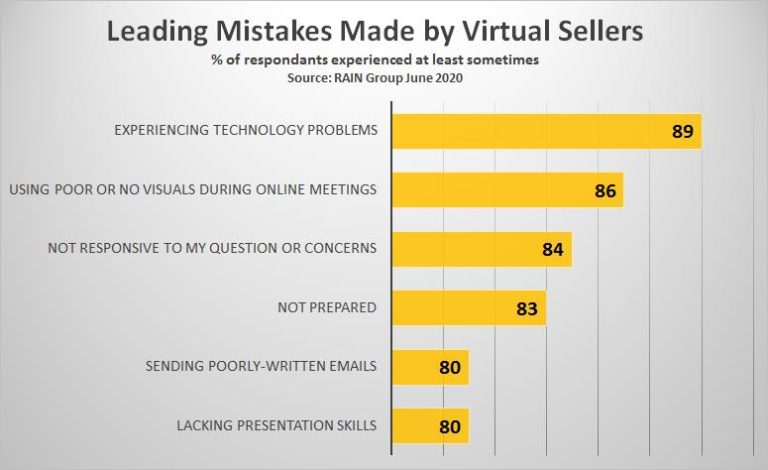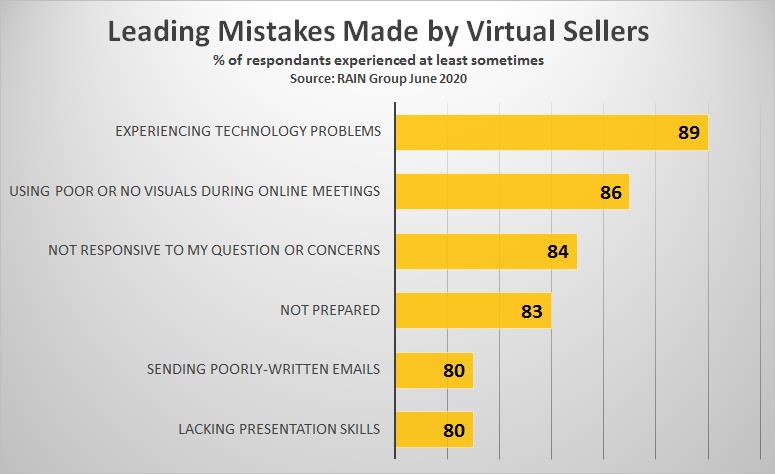Why Sales Teams Must Develop Virtual Selling Skills Now
Industry Focus
Thought Leadership
11 May 2021
What images and feelings come to mind when you hear the words “virtual selling”?
Robots? Technical problems? Fear? Maybe even excitement!
No matter how you feel, the reality is clear.Organizations must develop their virtual selling skills through sales training to acquire more customers, close more deals, optimize their sales performance, and ultimately increase top and bottom-line numbers. In 2020, sales professionals had to shift the way they were engaging prospects and customers.
To help you navigate this transition, today we’ll cover:
Virtual Selling Mistakes to AvoidA study by RAIN group in June 2020 found the top 6 mistakes being made by virtual sellers were: Let’s quickly cover how to handle these mistakes to ensure your team isn’t making them
Let’s quickly cover how to handle these mistakes to ensure your team isn’t making them
Challenges abound when it comes to virtual selling.
But when you know the challenges, and know which sales skills you need to improve, you can adjust accordingly.Final ThoughtsVirtual selling is here to stay.
Because every salesperson is engaging in some level of virtual selling, you don’t need to “revolutionize” the way you sell.
Instead, think about how to apply your virtual selling tools more effectively to engage and connect with other humans while boosting your sales productivity.
Organizations that invest in sales training to develop the skills to sell virtually will benefit not only now, but also in the long term because the circumstances of today are redefining what will be normal in the future.For further information :Website :www.optima-training.com
Email : contact@optima-training.com
- the benefits of virtual selling
- the challenges of virtual selling
- How to increase the productivity of your sales team with virtual selling
- Gives access to more stakeholders
- Allows you to build trust quicker
- Enables you to meet the changing needs of customers
- Increased sales team productivity
- cost
- time
| What | How |
| Apply interpersonal skills in new ways | Remember the principles of rapport building. Empathy. Authenticity. Similarity and Shared Experiences. |
| Learn how to influence and persuade without the help of some of your senses | Show that you’re listening and give positive cues. Look at the camera and not the screen. |
| Move at a faster pace | Customers will expect materials and documents to be shared quicker and meetings can be scheduled at short notice. |
| Get out of your comfort zone | Presenting your product or service virtually |
 Let’s quickly cover how to handle these mistakes to ensure your team isn’t making them
Let’s quickly cover how to handle these mistakes to ensure your team isn’t making them| Mistake | Solution |
| Experiencing technology problems | ● Test video, audio and lighting before the meeting. |
| Using poor or no visuals | ● Use images to capture attention ● Screen share. ● Avoid using large blocks of text |
| Not responsive to questions or concerns | ● Be prepared ● Understand what’s going on in the buyer’s world ● Use product demos ● Demonstrate your ROI visually. |
| Not prepared | ● Clear instructions on how to join the meeting ● Share agenda or materials beforehand. |
| Sending poorly written emails | ● Create a series of email templates |
| Lacking presentation skills | ● Train your team fully on how to use the virtual tools available. |
Latest Chamber News
- Industry Focus
- Industry Focus





